What do you use to aim your AR-15?
Iron sights? A red dot? Variable optics, an LVPO, a fixed power option?
It doesn’t matter. Okay, well, it does, but it doesn’t matter in regards to this article. Today we are talking about zeroing a weapon sight.
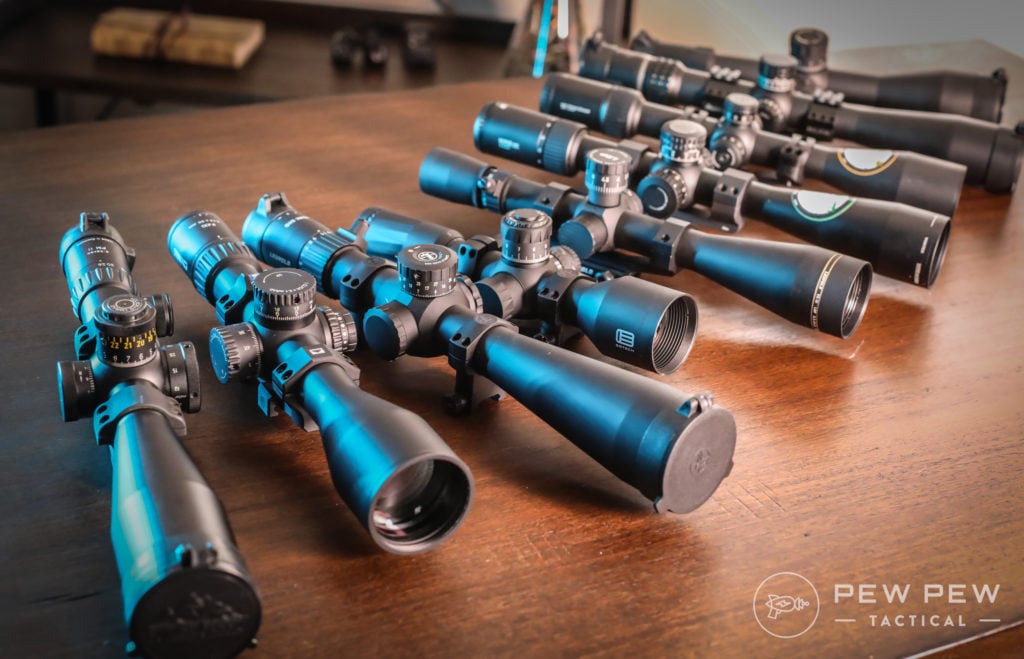
More specifically, the specialized “battlesight” zeroes you can use with AR-15 style rifles. These zeroes are specialized and designed to maximize the efficiency of your AR-15 rifle.
While the concept applies to any rifle or cartridge, these are designed for the AR-15 shooting 5.56/.223 Rem.
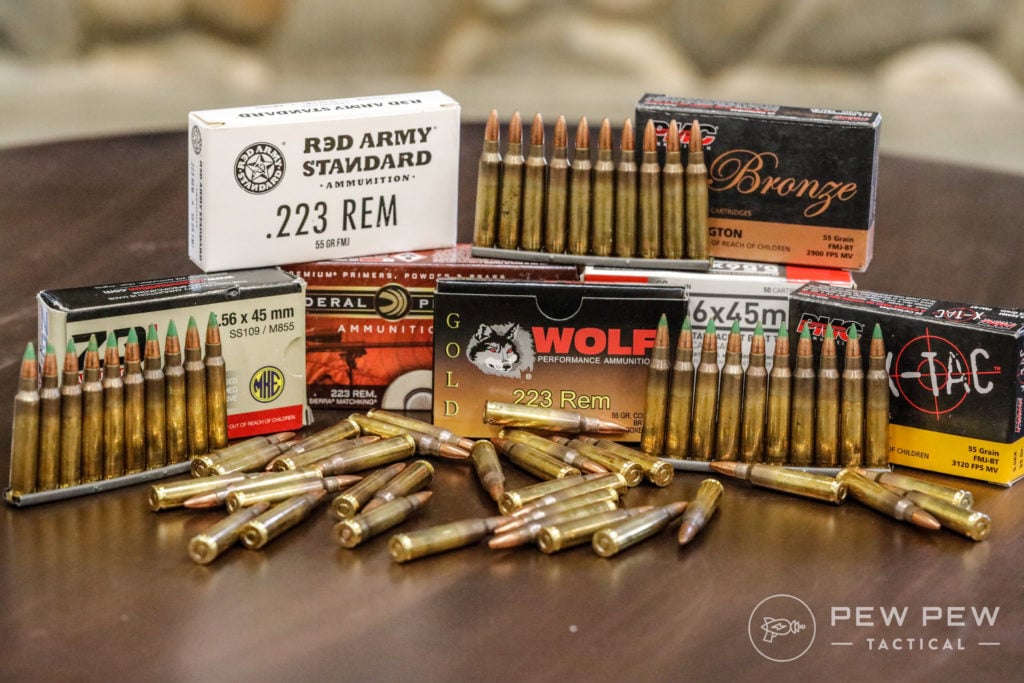
But before we dive in, let’s cover some terms and ideas you’ll need to know in order to understand battlesight zeroes.
We’ll also talk about why you might want to consider a battlesight zero and if it’s ultimately right for you.
But first, to get spun up on rifle ballistic terminology, check out the Brownells Daily Defense video below.
Table of Contents
Loading…
Any Range Zero
Let’s say you want to hit a target at 300-yards, and that’s it.
Do you have access to a 300-yard range? Well, then go out to 300-yards and zero your gun.
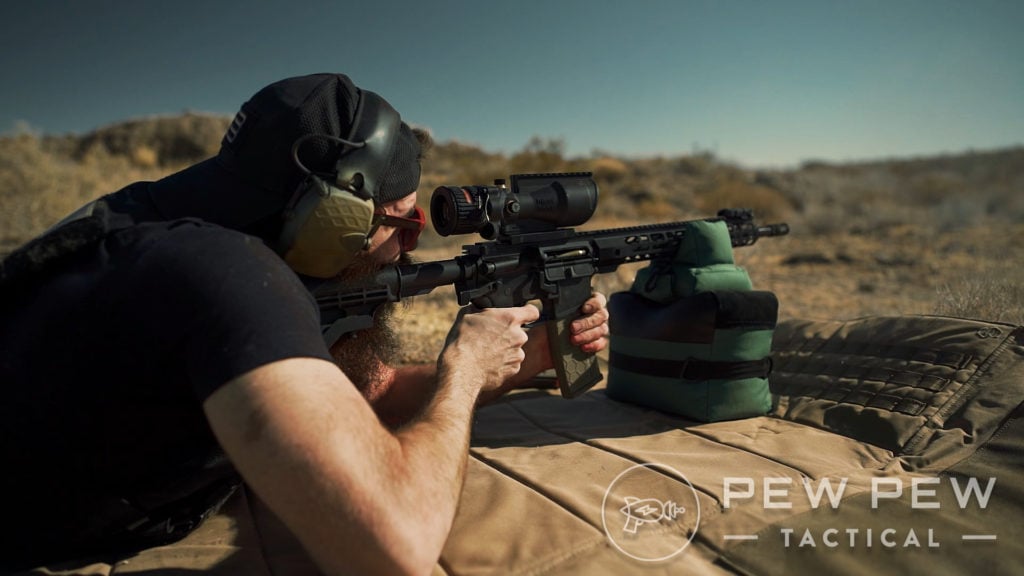
Or you can start at 100-yards, then move to 200-yards, and then finally 300-yards to get the zero straight.
This zero method is effective but requires a longer range to zero your rifle effectively. Also, you only know the gun is zeroed to 300-yards.
So what if I told you there was a more efficient and effective way to zero your rifle.

Maximum Point Blank Range
When I was a slack-jawed 18-year old, I remember someone explaining Maximum Point Blank Range (MPBR) and Battlesight Zeroes to me and nodding as if I understood.
I kind of did, but it wasn’t until I got behind a rifle and saw it in action that it clicked.
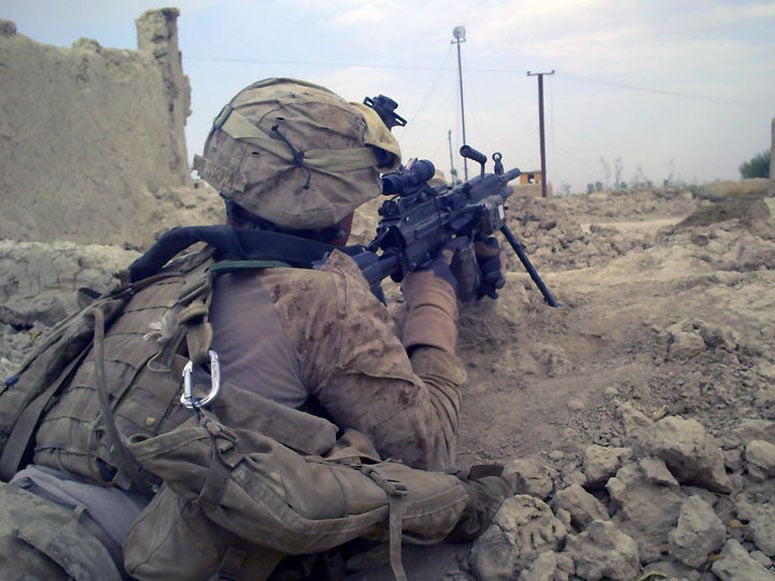
MPBR is an interesting concept that’s used widely by the United States military but it didn’t come from the military.
Hunters were likely the first to use MPRB with old-school scopes. These days we have fancier models with mil-dot reticles and bullet drop compensators allowing us to compensate for bullet drop.
They allow you to zero at a specific range, often very short, but the zero holds up to hundreds of yards. The military calls them Battlesight Zeroes.
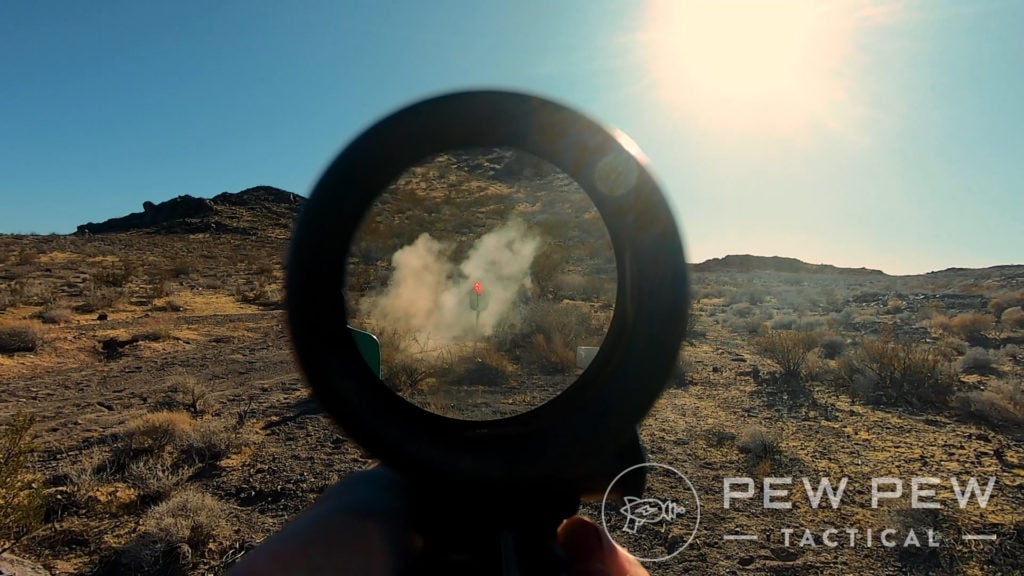
Imagine you have a target that is a 12-inch square. If you can aim at the middle of the square and the bullet’s trajectory doesn’t exceed 6-inches up or down up from 25- to 300-yards your MPBR would be 300-yards.
If the bullet drops more than 6-inches at 300-yards or elevates more than 6-inches at or on its way to 300-yards, you can’t hit your target and therefore do not have a 300-yard MPBR.
Simply put, MPBR is the max range you can aim at a specific sized target and still hit it without making adjustments for holdover.
The Line Game
Before fancy optics, hunters used MPBR.
To better understand MPBR, we need to talk about ballistics and how a round flies through the air.
Set your rifle down and look at the sights compared to the barrel and imagine straight lines coming from each.
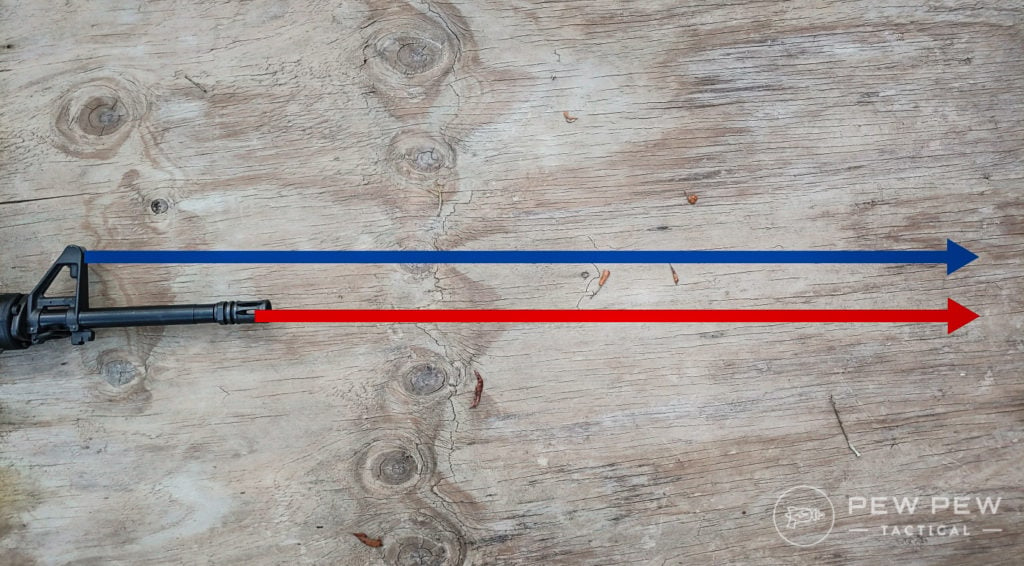
As you can see in the picture above, those lines run parallel to one another and do not intersect.
This is known as height over bore. In the picture, the sights are approximately 2.7-inches or so above the actual barrel.
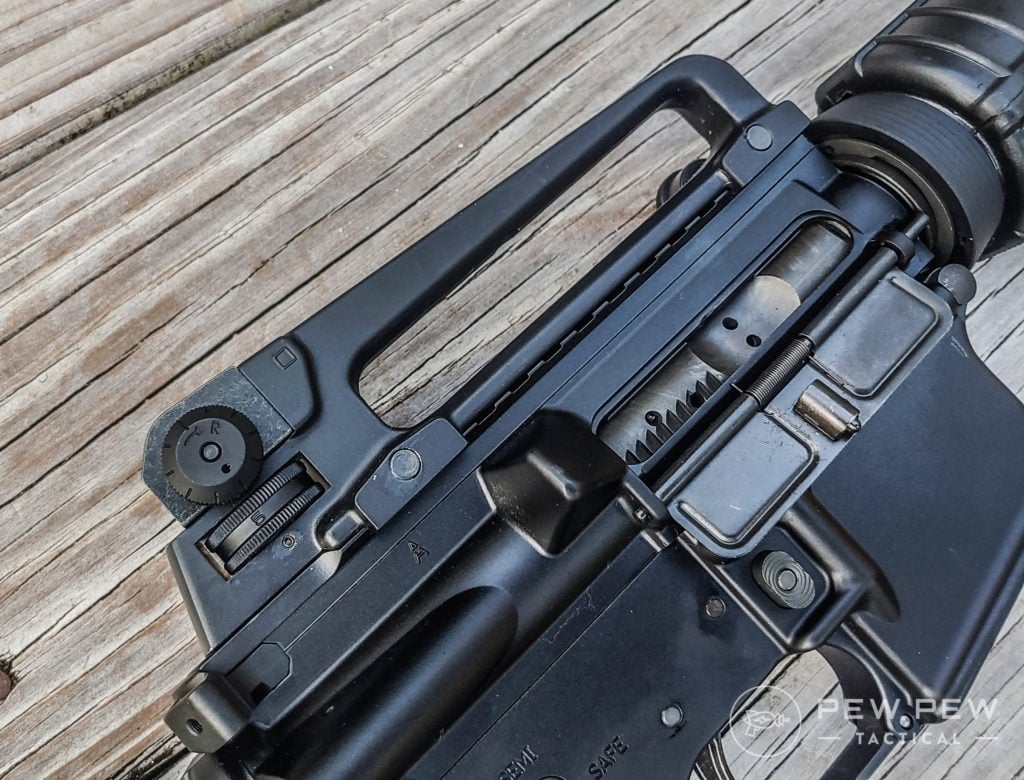
I learned about height over bore the hard way in 29 Palms California, training for my first deployment.
I watched a Marine with an M16A4 topped with an ACOG get in the prone and start firing.
He immediately decimated a rock in front of him and promptly missed his target.
As he aimed at his target with his ACOG, he couldn’t see the softball-sized rock a few feet in front of him and shot it twice without even realizing it.
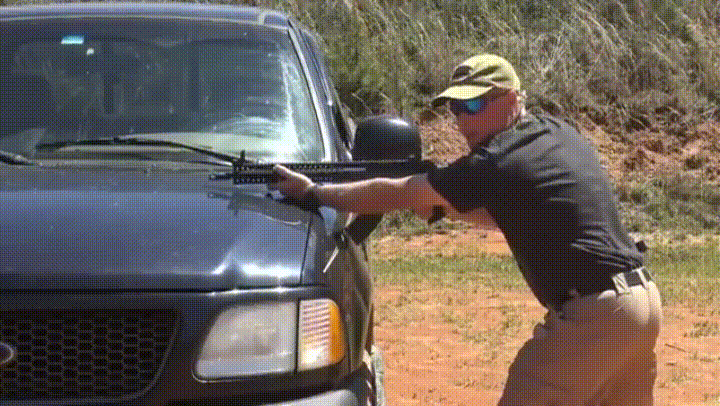
He obliterated the rock because the ACOG sat 2.7 inches above his bore…and he just couldn’t see it.
This is important to know because bullets don’t fly perfectly straight from the end of your barrel.
When you add sights or an optic to your AR-15, they are positioned to be aimed slightly downwards.
This causes your barrel to be somewhat inclined.
Are You Inclined?
An inclined barrel ensures the trajectory of your round’s point of impact meets your point of aim.
Go back to your straight lines.
Incline the line from your barrel, and it will cross the line from your sights. This is where the point of aim meets the point of impact.
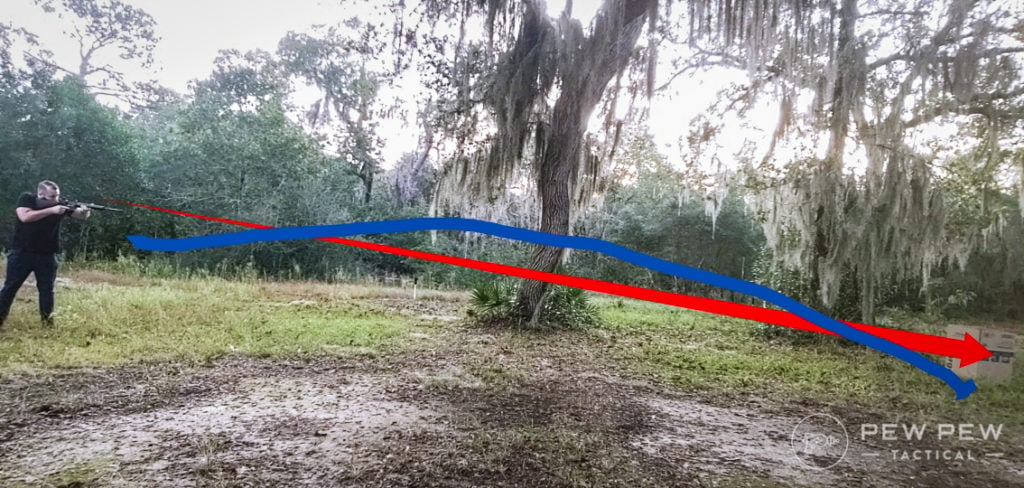
When we zero, we connect the point of aim with the point of impact.
Additionally, that incline maximizes the range of your weapon.
Despite what you might have heard, the bullet doesn’t magically drift upwards when it leaves the barrel. You are aiming slightly upwards.
Like any object on Earth, bullets are subject to the effects of gravity, meaning the second a round leaves the barrel, gravity begins pulling it towards the ground.
The sighting system on AR-15s allows us to maximize our range by aiming slightly upwards. So, bullets go up and then come down in an arc.
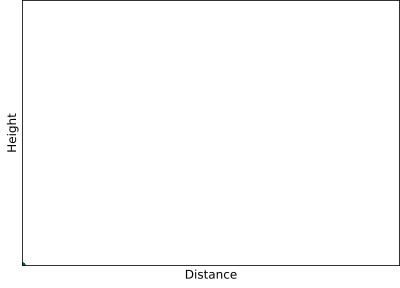
As a round travels, it does not stay entirely in line with your point of aim. It can go below, or above it depending on the range of your target.
Here’s the thing…your point of aim and point of impact can meet at two different ranges.
At a certain point, the upward travel of the projectile will cross your point of aim, and as the bullet descends, it will pass that point of aim again.
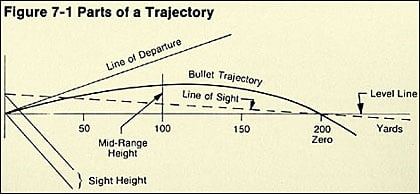
The first time your POA and POI meet is known as Initial Intersection.
The bullet will continue to climb a bit and, at some point, will reach what’s called the Maximum Ordinate. This is the height of the highest point in the trajectory of a projectile above the horizontal plane passing through its origin.
Once the bullet begins its journey back towards the ground, it will eventually cross your line of sight again, and this is called Terminal Intersection. And that serves as the furtherest zero range you’ll have.
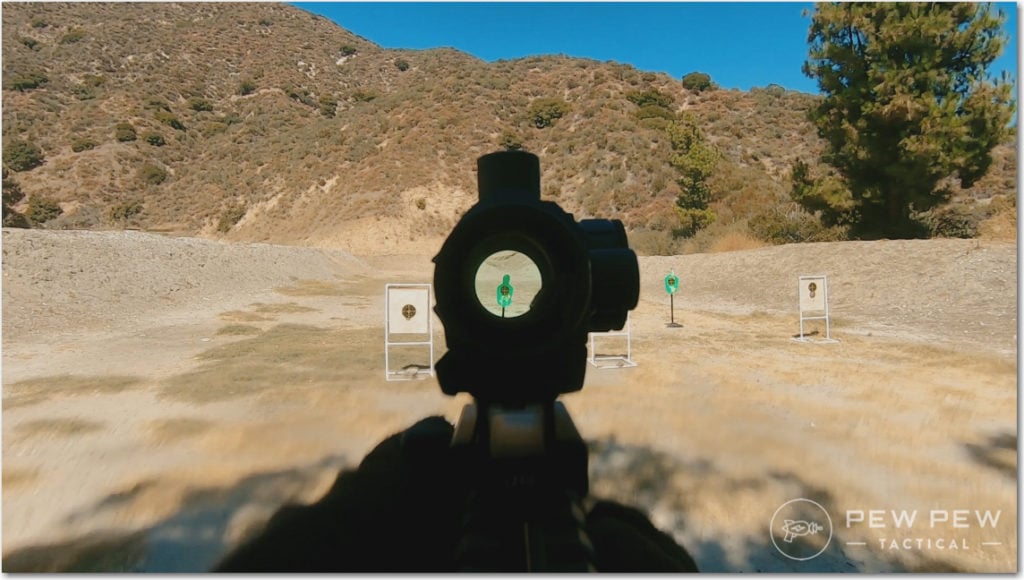
Brownells Daily Defense talks about this in the video below, so check that out.
Two Ranges, One Zero
All that leads to why Battlesight Zeros are represented by two numbers.
For example, the 50/200 zero means that the point of aim coincides with the point of impact at both 50- and 200-yards.
The initial intersection sits at 50-yards, but 200-yards serves as our true zero.
Basically, I can zero at 50-yards, but know I can still land a shot at 200-yards.
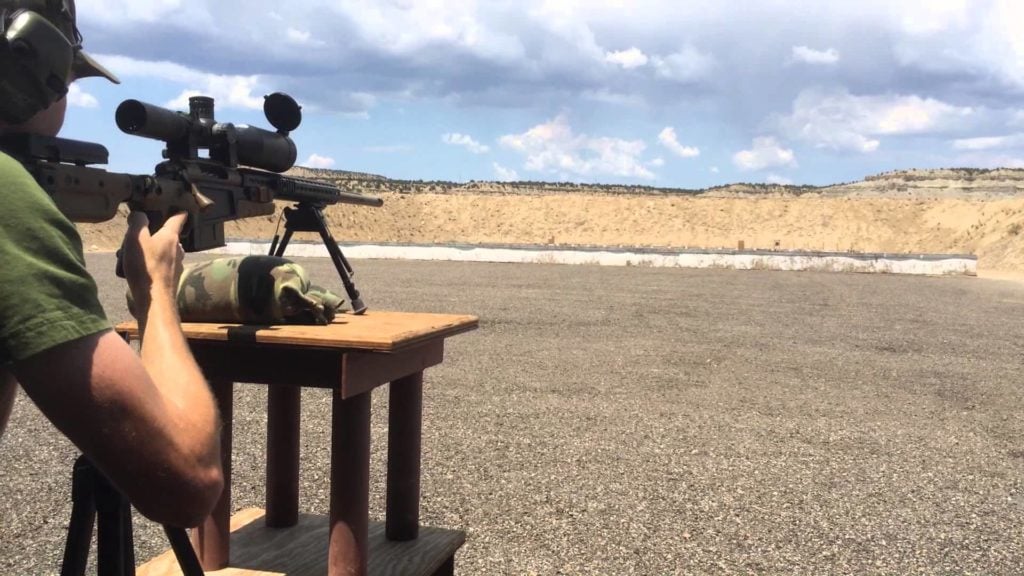
Using an MPBR zero, you can also zero at shorter ranges. This proves useful as you may not always have access to a 300-yard rifle range or even a 200-yard rifle range.
Typically, 50-yards, 36-yards, or 25-meters are accessible. So, this makes zeroing a lot easier.
What about the ranges between 50-yards and 200, you ask? What about ranges closer than 50-yards and further than 200-yards? Man, you guys ask all the right questions.
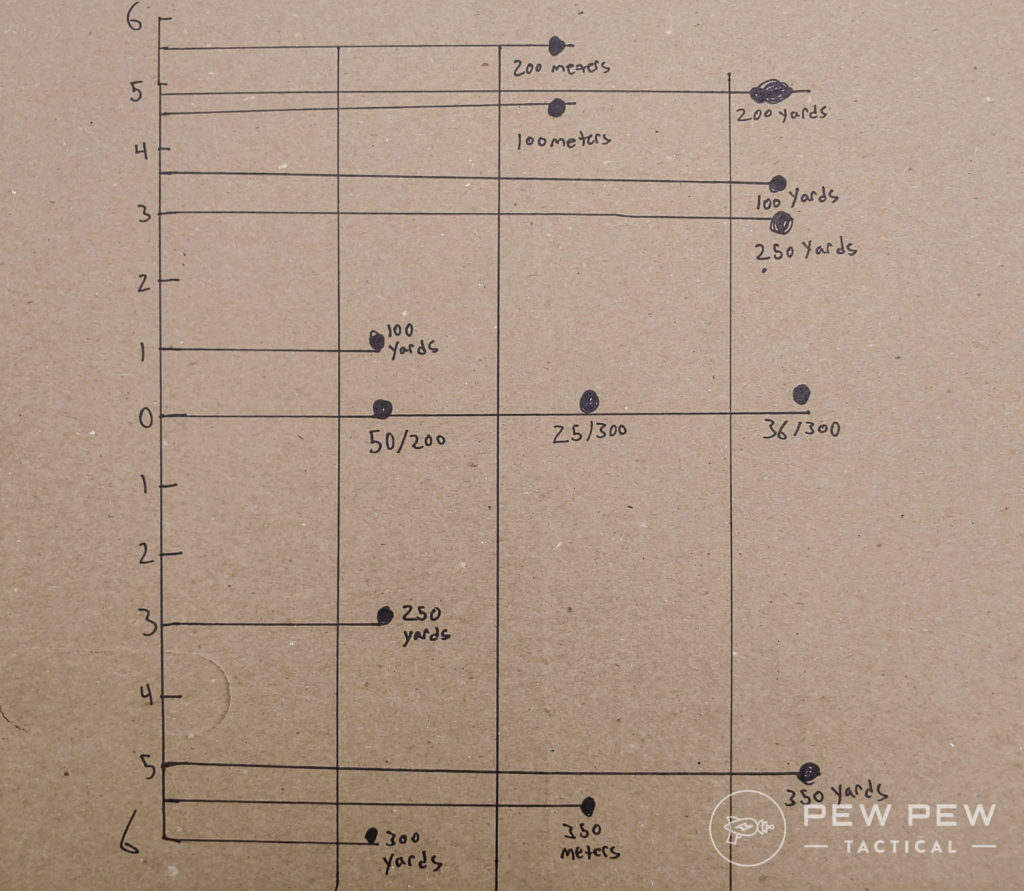
At ranges closer than 50-yards, you’ll likely hit a little low on the target — maybe a few inches, but in close quarters combat, this won’t be a big deal. You’ll still be punching his clock.
And at 300-yards, you’ll be hitting low as well.
Now we can circle back around to Maximum Point Blank Range zero I addressed at the beginning of this whole mess.

That 50/200 zero is an MPBR zero. MPBR typically takes target size into account when planning.
The 50/200 is a defensive MPBR designed for a torso of a human being. That’s a pretty big target.
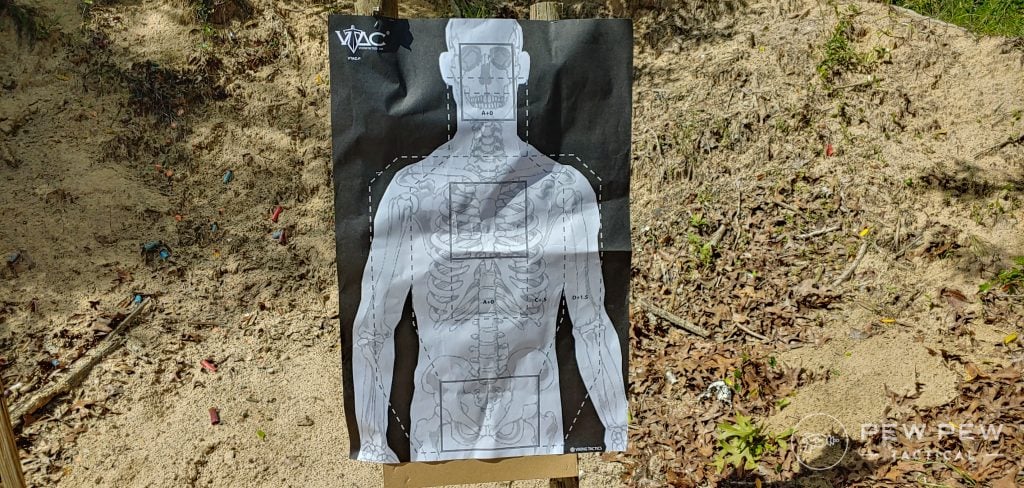
With the 50/200 zero, I should be able to place my front sight, red dot, or reticle in the middle of a target and hit it at ranges between 50 -and 200-yards with excellent precision.
I will not have to make adjustments to compensate. I bisect my target in the middle and shoot.
Best AR-15 Battlesight Zeroes
Sure it’s not the most precise means to hit a target, but in combat, you want quick and accurate.
An MPBR zero allows you to do nothing more than put a sight on the chest of your target and pull the trigger with a better-than-likely chance you’ll hit it.
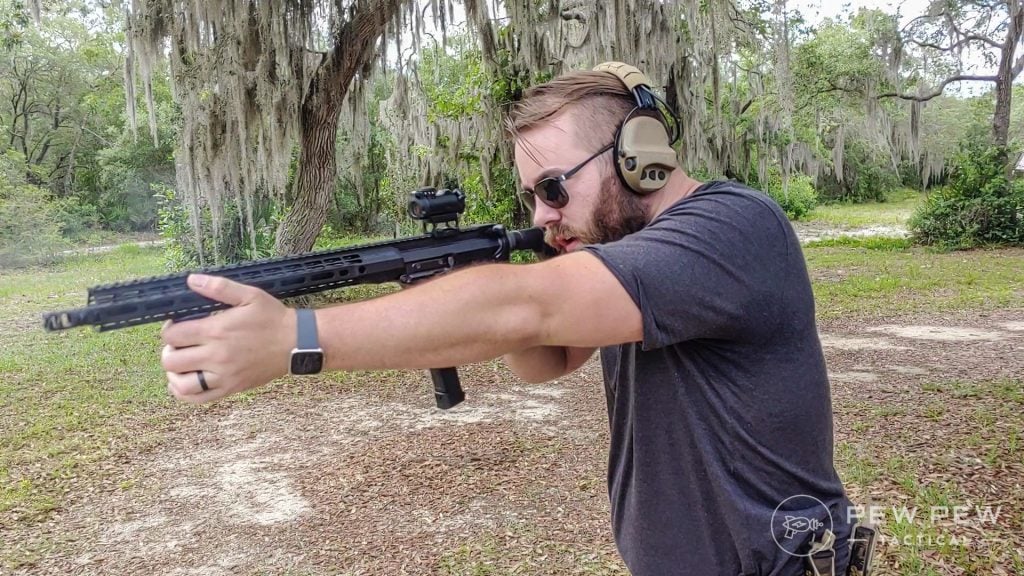
Even with a 50/200 zero, your MPBR isn’t 200-yards. Max range to hit a man in his torso could be as far as 300-yards, but you’ll hit him closer to his belt buckle than his chest.
While we’ve talked extensively about 50/200…that’s not the only MPBR on the table.

So let’s examine the different MPBRs and their place within AR-15 shooting.
Keep in mind these zeros are designed for man-sized upper torso targets.
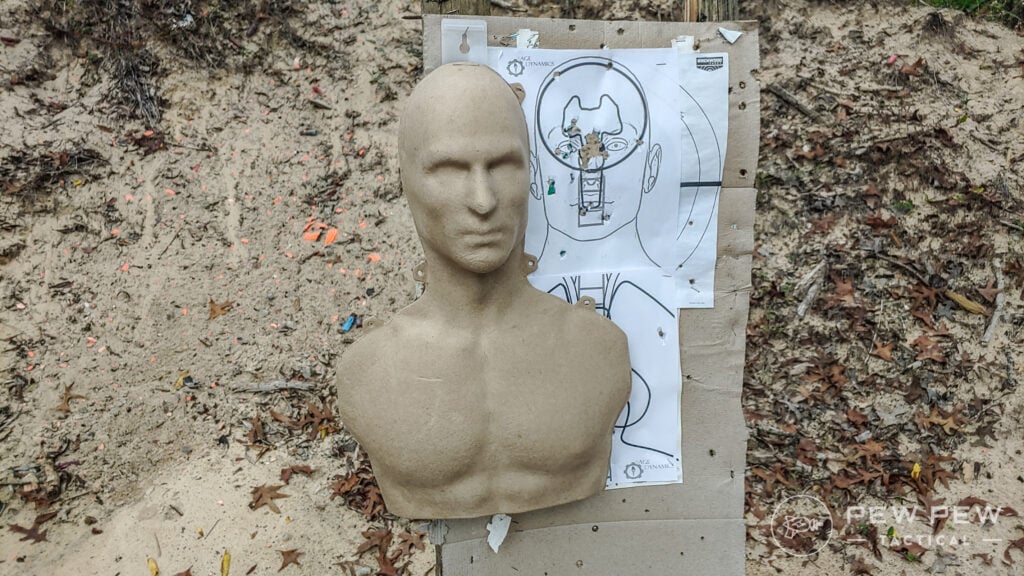
If you want to hunt with an MPBR, rethink these numbers based on the target size and the caliber you’re using.
1. The 50/200 Yard Zero
The 50/200 yards zero is, in my opinion, the best zero for police and civilian shooters.
It’s very precise but does limit you to 200-yards. That said, that’s perfectly fine for most police and civilian engagements.

Most police are unlikely to find themselves in engagements beyond 200-yards.
If a target is beyond 200-yards in the police world, you probably won’t take the shot unless forced to.
Beyond 200-yards makes it a lot easier to miss, and if you miss, where is that bullet going?
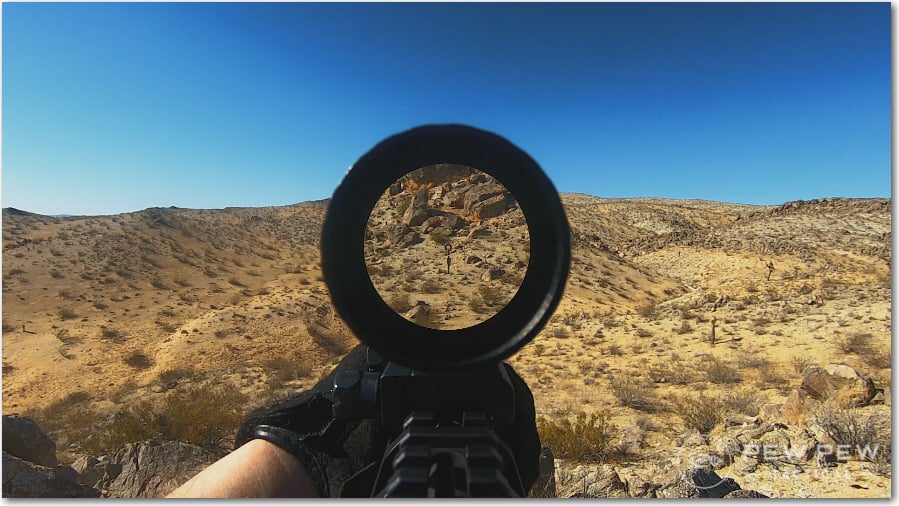
Civilians are even more unlikely to find themselves in this situation and will also have a much harder time justifying a long-range shot as a self-defense shot.
The 50/200 zero is highly precise at 50- to 200-yards. With a 50/200 MPBR zero, there is only a 3- to 4-inch difference in point of aim and point of impact from 50-yards to 250-yards.
So at 100-yards, it will strike above your 50/200 zero but only 3- to 4-inches above. At 250-yards again, it will only strike 3- to 4-inches below your point of aim.
Best of all, you can zero your rifle and optic to this 50/200-yard setting at 10-yards.
Frank Proctor has a great video on that below.
2. USMC 36/300 Yards
Do I favor the 36 to 300-yard zero because I used to be a Marine? Maybe, but I also find it to be highly effective and extremely versatile.
Plus, to be fair, I’m better at using yards than meters because I use Freedom units.
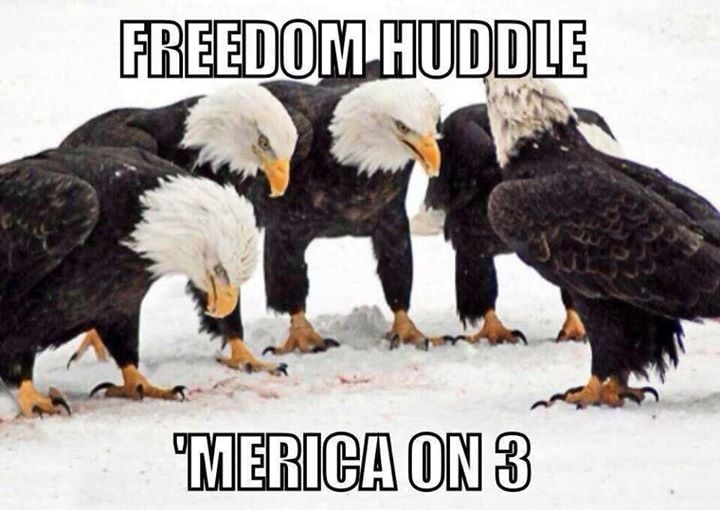
Although the Marines adopted the ACOG, which uses meters as its BDC, we still shoot in yards. It was a point of contention on qual day.
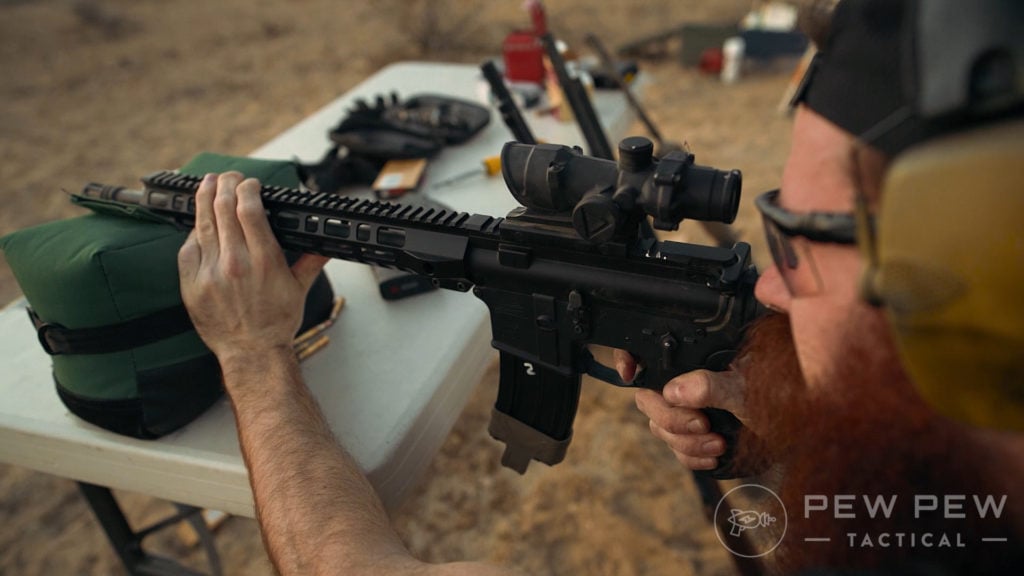
The USMC method sees you zero at 36-yards for the initial intersection and that gets you all the way out to 300-yards.
Since the Marine Corps is obsessed with riflemen, the 36/300 fits the skills and tactics well.
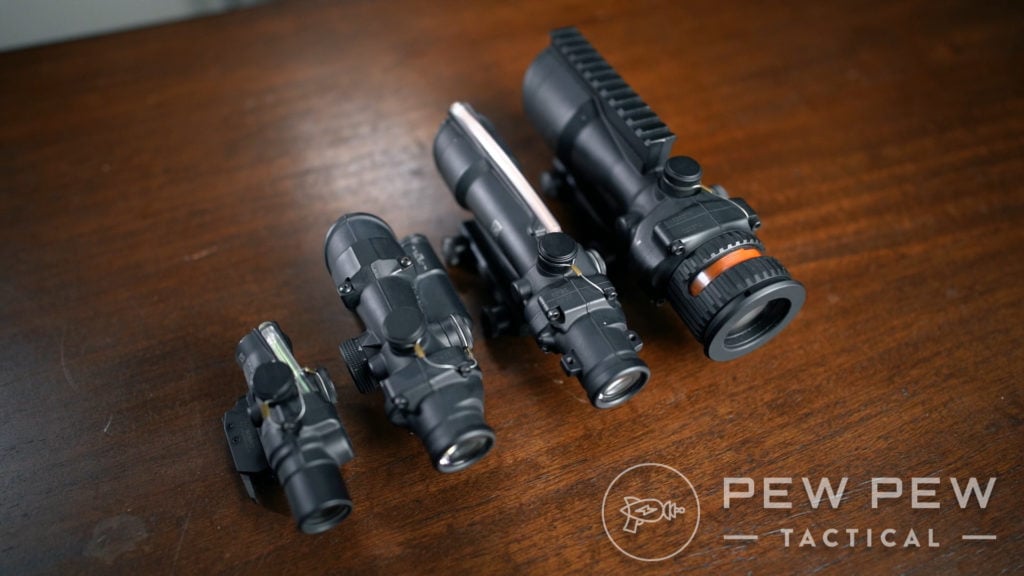
From my experience, a 36/300 zero will keep your 5.56 projectile inside of 5-inches from your point of aim all the way out to 300-yards.
It’s boringly reliable and predictable from M4 and M16 rifles and their civilian equivalents. And this translates well to the torso of a human target.
At 350-yards, you can still hit a man in the belly if you aim at his chest — you’ll just see a 5-inch drop from your point of aim. So you can still effectively engage a target out to 350-yards.
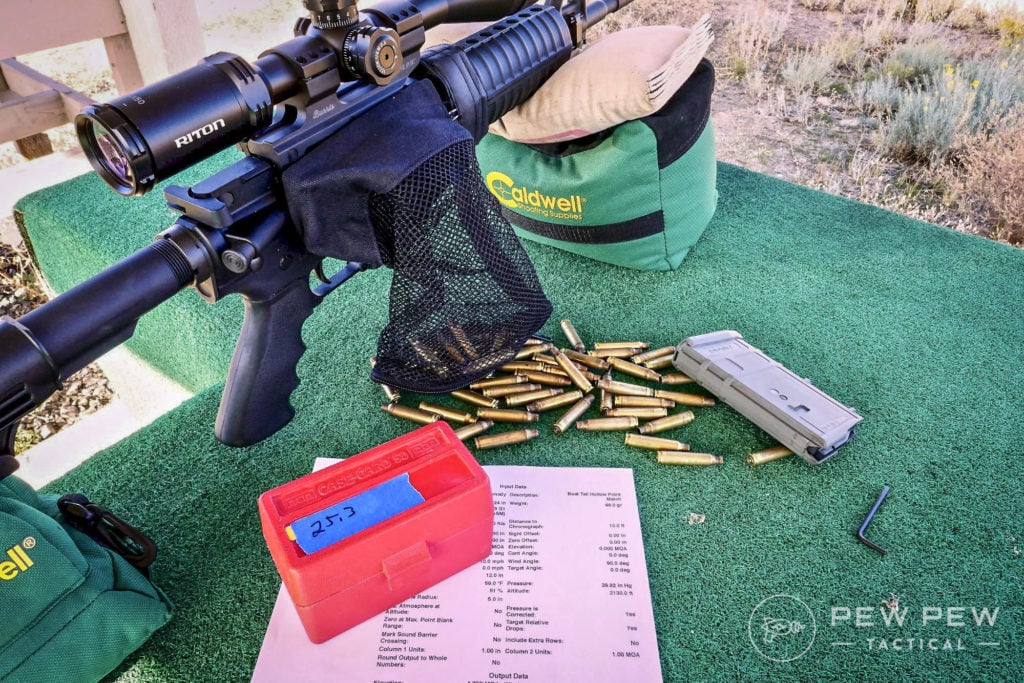
The USMC zero is best for extended-range shooting.
At closer ranges, from 100 to 250ish, you’ll hit high but still within 5-inches of your zero.
3. The Army’s 25/300 Meters Zero
The Army made a move to meters — I guess to make it easier to communicate with our NATO allies and better coordinate equipment and gear.
Whatever reason they have is lame, and NATO should conform to us cause ‘Merica.

Anywho the Army’s zero is comparable to the USMC, offering similar range potential. That said, it brings slightly less range than the USMC’s MPBR zero. So it can be a little less precise.
Between 25- and 300-meters, the zero will give you 6-inches of flight variance compared to the USMC’s less than 5.

But the Army’s method is easy to use if meters are your game.
The Army’s zero also allows you to get out to 350-yards, but you can expect a little more than 6-inches of drop.
What About .300 BLK, 7.62, etc.?
What about my AR in .300 Blackout? Or 7.62×39? What about my Mk 18 with a 10.3-inch barrel?
What if I’m using a 150-grain .223 round made of Vibranium?
Good questions. Well, to figure that out, you’ll need a ballistic calculator.
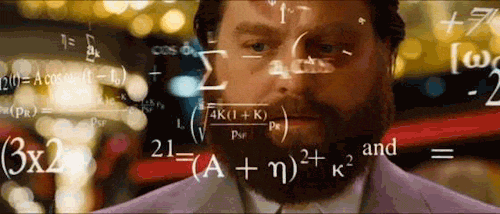
These are easy to use if you have some basic information:
- Ballistic Coefficient of the projectile (read more about that here)
- Velocity of the projectile
- Target Size
- Sight height over bore
StrelokPro is free and can be downloaded to your phone (Andriod Link). You can plug your data and come up with your own MPRB and zeroing scheme.
If you’re on a real computer, ShootersCulator.com has a great MPBR calculator. They also have some other fun things, I recommend taking a look!
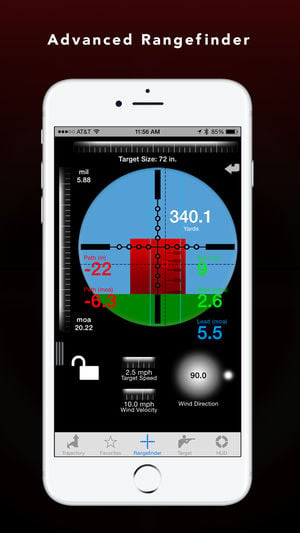
We’ve got other recommendations in our Best Ballistic Calculator App article.
The above models are designed for AR-15s in 5.56 and .223 in standard barrel lengths. Don’t get crazy with caliber and barrel length, and expect the same results.
Final Thoughts
Making your own MPBR is simple and easy. That said, always make sure to confirm your zero at the close end and at the far end if possible. Trust, but verify.
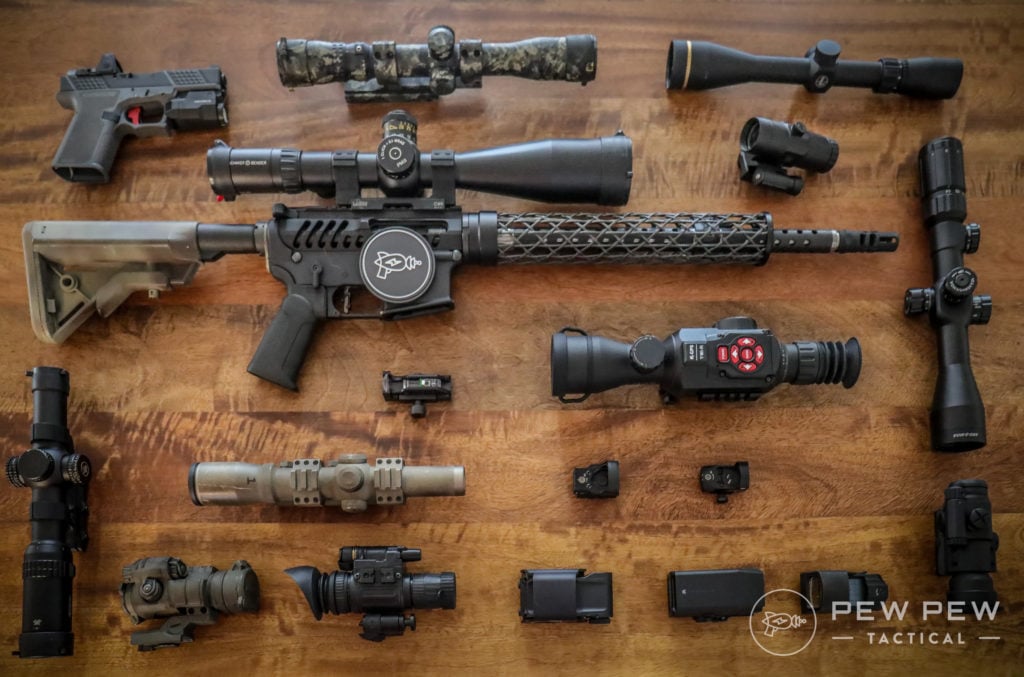
So which zero is for you? Let us know below. Want an optic to go with your new zero? Take a look at the Best AR-15 Scopes & Optics!

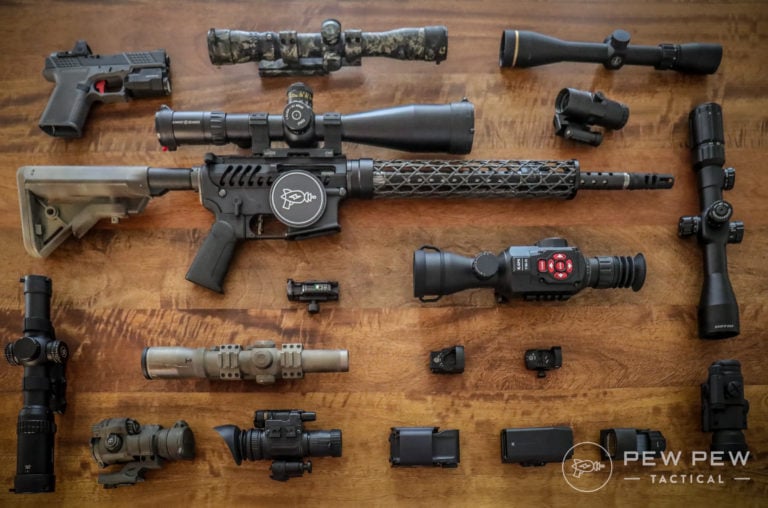



66 Leave a Reply
When your pop up blocks the website I close the tab and leave the website.
Why do you are it a challenge to read the website?
I’ll go sight in with them this weekend after sighting in my new Brownell’s carry handle retro scope
Effin-A...Semper Fi
I didn’t see a mention of bullet specs for this article. Were we talking 55gr. 109s or 62gr. 855s? Or, are POI differences of those two at any of the Battlesight Zeros so minor it doesn’t matter?
Nice article. I started using point blank radius in a hunting application 25 years ago. It didn't take long to use this technique in all of my shooting applications. IMHO, you really need nothing else.
Go get a dictionary and look up "decimate."
Need to know if there is a chart for yards to zero your rifles and what distances can you shoot after you have zeroed your rifle, like if you zero your rifle at 25 or 36 yards, you can hit a target 300 yards out.
Like
zero yard target distance in yards
25 to 50 yards up to 300 to 350 yards
75 to 100 yards ?
150 to 200 yards ?
250 to 300 yards ?
Great article. Thanks Devil.
Excellent article
I liked the article, but am I missing an understanding of the Chart drawn that explains bullet placement at Meters and yards. I grew up with meters being just a tad longer than a yard(s). So, unless I'm wrong the chart is wrong.
This is without a doubt the simplest to follow description of what's going on when sighting for Zero.
I understood things that I had trouble with other descriptions.
Thank You.
Great article! Learned a bit and got reminded of a few things I had forgotten. Thanks for posting this. The free ballistic calculator links were great too.
One note - StrelokPro for android shows up as an $11.99 app on the store. The regular non-Pro version (which your link points to) is free. Not sure what the differences are, but thought it was worth noting.
I noticed that too. When I hit skip, it loaded the Free Version.
Great article with very simple-to-understand explanations. I will be using the 50 yds MPBR. All I am interested in doing is engaging bad guys at close range with my 1980 Colt AR-15 Sporter HBAR with the Colt 4x20 scope. All my defense shooting would be in an urban setting, so, no long shots that my 73 aged eyes could not see anyway. Much thanks for the informatin.
Just an observation to those training for 2 legged predators, if you're engaging much past room sized distances here in the US of A, you got some serious 'splaining to do. I doubt many "duly elected" prosecutors here in the mid-west would see it otherwise. I understand there might be the occasional exception in Texas or Arizona these days. Very good explanation of an otherwise overly complicated topic Mr. Pike, thank you. Many LE officers I've worked with employ 50 or 100 yard zeros but rarely have to engage beyond 25. I'm fond of a 40-50 yard red dot zero too, mainly because that's about as far as I can see these days without some help. Thanks for being there for us, sir.
How does an article published 2 days ago have comments posted from 2 years ago???
Hey Charles! Astute observation! We regularly update older articles to ensure we're bringing the most up-to-date info to our readers. So, that's why you're seeing older comments because this article originally ran a couple of years ago but was updated this week with some new stuff. Thanks for reading!
I am going to take a wild shot in the dark and say it is an old article that they recycled and "re-published" recently...
I hunt feral hogs from 75 - 150yds., so the USMC method probably works the best for me. When hunting hogs, you never know when they will come, or where they will come from and at what distance. In the brush, you need to be ready to shoot quickly, with no time to use a rangefinder and adjust scope DOPE or even to mentally calculate your reticle adjustment (holdover-under), as Tom's comments below confirm. Hogs don't present a large target like the human torso, so sometimes you have to guesstimate when hunting alone. A spotter with rangefinder helps, but I still don't deviate much from POA. Sometimes you they end up gut-shot, but within 100yds you can get a clean one-shot kill. Anxious to find a MPBR and zero distance for the 6mm A.R.C.
You can choose your zero distance
With a 1.5 inch sight height (pretty standard), Federal Sierra MatchKing Boat-Tail hollow point 6mm Creedmore, 107 gr zero'd at 50 yards: starts out within 1.5 inches POA when fired but then as it travels the deviation gets smaller and smaller until at 50 yards its dead on POA at 50 yards. At 100 yards it is about 1/2 inch below POA and at 200 yards its about 2 inches below POA. This should pretty much get you hogs (if that's what you are interested in) out to about 200 yards with fairly accurate shots.
Great info for combat, learned a lot.
For hunting (i.e. using .308 bolt), I prefer using the Maximum Ordinate of the round and scope height I'm shooting as my zero. Knowing my bullet's MaxOrd distance, all other points before and beyond that distance will be below my PoAim and easier to calculate in my head, since I Do have time to calc and aim..
THANK YOU for helping demystifying zeroing! Couple of comments:
1. Is the barrel line in the pics blue or red... or is it inconsistent?
2. Typo: ""Despite what you might have heard, the doesn’t magically drift upwards when it leaves the barrel." (The what? The what? :)
Thank you for catching that typo! Sometimes our fingers type faster than our brain. Lol
For a new build or new sights/red-dots I do an initial 50 yard zero at 10 yards out back with Federal American Eagle 5.56mm 55 Grain FMJ XM193BL. Its within 2 inches of point of aim all the way from 10 yards out to 200 yards. I then bench rest check it at the range at actual 50 and 200 yards and some other distances in-between those and sure enough its within 2 inches of point of aim and dead on at 50 yards.
50/200 yard on the optic
100 yard on the 45 degree back up iron sights
Well, sorry to bust balls, guys but not much of this matters in real time hot combat situations. Such as the Kyle Rittenhause situation but maybe 'upgraded' to several rioting maniacs shooting at the same time at him. And the further out you are from CQB ranges (under 50 meters), the safer you are because this reduces the enemy's effective point-blank range. (the call it 'blank' because it's realized as the maximum 'ineffective' range aka the range where your target is blank from No hits from sighted in zeroes point of aim. Which means several other variables notwithstanding the 'battlefield zero' like cross wind vector, bullet and barrel accuracy, shooter skill under stress, etc. could and would and does easily open up the PBR to much more than six inches at 200 meters, right off the jump shot.
Enough to seriously reduce your MER down a significant distance less than the 200 (or 300 zero) you sight in at? Also, that's why the 'battlefield zero' was 'invented'. In most cases under all those variable considerations, it's almost useless after 400 meters in actual combat engagements. It's far more tactically prudent to NOT engage at all if possible.
And, of course, that's why the Army has 50 bmgs and mortars, and etc. And well trained snipers for reaching way out if tactical situations require it for advantage.
In my jungle fighting days, we (my team) figured out that in the heat of battle, or often encountered 'sudden heavy-contact' (ambushed by above a squad level enemy, and pinned down), we used something else besides a 'battlefield' zero. It was called SFAB (Superior Firepower ASS Blasting). We all instantly flattened out and just layed down as much full auto suppressive fire as fast as we could switch mags by holding the weapons above our bodies in the cover foliage usually with one hand sticking out only point shooting (m-16 shorty CAR-15s were great for this) to give the two M-60 gunners a couple seconds to I.D. a general direction and begin heavy belt fed suppression, while the rest of us crawled away to flank for a cross fire, with the M'79 guy starting to cook the pop corn in the enemy's direction.
That tactic always did the trick. Usually all over in less than a minute. Always minimal casualties on my team. Enemy destroyed or just hit and run. Actually never failed tactically in over my 3 years of this type of day in and day out action. (We also did offensive night ambushes and that's when the Claymores did the initial 'shock' 'aiming' for us. And we just threw grenades, pointed and sweap back and forth with the 60's doing most of the heavy-hitting).
So the moral of this trip down psycho memory lane is... that although I can vividly recall the action and follow-up on enemy 'remains' and attending to our own wounded. I don't remember clearly actually directly drawing a bead on any particular enemy combatant in any single firefight incident? Except when they sometimes attacked our base camp and got inside the wire at night, but no stand-still 'battle sight' aiming, other than rapid point shooting usually while moving. Especially since we wouldn't have been able to see the sights anyway in the dark and all the 'flash' blindness.
...Just thought you boys would be interested in a step back into reality land at this point in your training...
So don't take your 'sighting' system so seriously. I know it's fun, but It's probably better to just practice enough with your main 'go gun' so that you can hit your target out to 100 meters with 90% plus efficacy While you are practicing moving to cover or flanking. Remember, it's all a different pile of shit than a stationary target that's not shooting back to 'interrupt' your 'well-placed' battlefield zeroed group shot, LOL!
Besides, if you are really shooting out passed 200 meters, or even a hundred, and it's not a snipe or surprise ambush to the target, you shouldn't be engaged. You should fall back to either regroup out of danger, or to re-established another undisclosed fire advantage before you engage, or to just disengage all together and live to fight another day. This time with more of an 'advantage'.
Keep up the great work!
M/Sgt P.J. - thanks for your service and the dose of reality when the SHTF!
This would have helped me so much in my army career. They take us to a tiny range to zero. Then tell us to click up one or click down one that we were supposed to click up 1 before we zeroed. Had they just drawn a picture of the the arc and why we clicked 1, I would have understood completely for the next 13 years. And could have helped others. I still shot well. But not as well as I could have understanding the arc
Ps. I was a geodetic surveyor. 82D back then. Don't know what that is, neither did my recruiter. There 'were' only about 200-300 of us worldwide. NCOs and officers were issued M9s. Not rifles. We didn't range often. Went into reserves after 5 years for 8 more as an electrician. Still not a range mos. But over years I heard aim low or aim high at this or that. Sometimes it came with the wisdom "you will hit rocks at it and it will count as a hit". That one pic of the arc and target relationship would have been better.
Just a funny observation . . . NASA uses the SI units system, which is in most cases METRIC, so TECHNICALLY it was the metric system that got us to the moon. Ha ha ha ha
Technically, both. NASA used metric but the readouts for the Apollo mission pilots were displayed in imperial.
No, technically metric.
Those imperial readouts were calibrated with Metric measurements. All imperial units are metric, has been for nearly 150 years.
Sure the tape measure might show you 1 inch but what you're actually using is 25.4mm.
Doesn't matter whether it's feet, inches, yards miles, whatever the unit is, it's metric.
It's really a 50 yard/200 meter zero and not a 50 yard/200 yard MBPR, its actually a zero. Next, your MPBR isn’t actually, or may not actually be, 200 yards (although if you are within your desired area +/- that satisfies you then you could call this your MPBR). And again next, this -1.9 inches POI below POA Proctor and everyone else is using is for a sight height above bore of 2.5 inches for an AR and not the standard 2.6 inches for an AR and it makes a difference as does the ammo being used. For example, with a red dot height above bore of the standard 2.6 inches for an AR, with Federal XM193 factory load boat tail 5.56 at 10 yards the POI is - 2.0 (not - 1.9) inches below POA with a first intersection at 50 yards of 0.0 inches deviation (which is the first zero intersection with LOS) and the second intersection with LOS at 231 yards (and not 200 yards) at 0.0 inches deviation for zero. With the same ammo and everything else, but using a height above bore of 2.5 inches the POI at 10 yards is -1.9 inches below POA and the first zero intersection with LOS at 0.0 inches deviation is at 50 yards but the second intersection with LOS at 225 yards at 0.0 inches deviation. So actually measure your sight height above bore and make sure because a lot of people with standard height above bore of 2.6 inches are taking for granted the -1.9 inch 10 yard zero method and getting deviations they try to reconcile at 50 and 200 yards when their actual second intersection is beyond that and they are actually probably zeroed but don't realize it because they take the 2.5 inches and 50/200 yard as gospel.
Just to clarify. And I understand what you are saying - you did leave a few details out. You are talking about the 10 yard zero method where the correct zero for first intersection with LOS is 50 yards. And the federal xm193 is 55 grain.
But yeah. I've noticed this too. Much better at 231 yards.
Your post answers some questions I've had about the 50/200 at 10 yard zero. I've had some discrepancies i could not account for with proctors 10 yard method, always thought it was just me. I had always expected the rounds to be grouped around -1.9 below aim point at 10 proctor said so would adjust for that but then at 50 yards i would be off from where it should have been grouped so i would need to rezero at an actual 50. I was using the wrong height above bore and taking the -1.9 for granted. After measuring the red dot height above bore like u said and accounting for this i was able to use the 10 yard method and the discrepancies went away at 50. Have not been able to chek the "200" yet but wiil go check out at around 230 instead when I can. Thanks for bringing this up.
Your post answers some questions I've had about the 50/200 at 10 yard zero. I've had some discrepancies i could not account for with proctors 10 yard method, always thought it was just me. I had always expected the rounds to be grouped around -1.9 below aim point at 10 proctor said so would adjust for that but then at 50 yards i would be off from where it should have been grouped so i would need to rezero at an actual 50. I was using the wrong height above bore and taking the -1.9 for granted. After measuring the red dot height above bore like u said and accounting for this i was able to use the 10 yard method and the discrepancies went away at 50. Have not been able to chek the "200" yet but wiil go check out at around 230 instead when I can. Thanks for bringing this up.
The anti-metric spit-balling -- what's the point? It's just making the connection between shooting sports and physics education that much more difficult to draw, and that's a connection we should be strengthening. Guess what you can do in Imperial units? Measure anything related to electricity. Those units stopped being updated a long time ago. It's just holding the sport back.
36yds unless an optics manufacturer says to do otherwise based on their reticle design
USMC 66-72, 25 yard sight in for 300 yard battle sight. my M14 in 66 and for my m16 in 68. On target every time. If I could see ya I would hit you .
I'm pretty sure the Army's zero is longer range than the Marine Corps' as stated.
Really good information, especially for those of us kind of new to the use of optics on our carbines and rifles. So I thank you. I do have to ponder whenever I hear folks argue about meter vs. yards. Unless one is using a range finder can you really tell the difference between 200 meters and 200 yards when estimating the distance with the eye? The difference is about 18 yards (56 feet). This amounts to less than 10%. Can shooters estimate better than +/- 10% under pressure? Just a question. I don't know the answer.
It really depends on the person. I remember watching a documentary years ago about Olympic archers and how almost 50% of the men's gold medal winner's training time was spent estimating ranges. He could see and call the difference of a yard or two, it was impressive. You can absolutely train the skill of range estimation, but with rifles, it normally doesn't need to be perfect. It's also something that only needs to be done in whatever your favored flavor of range is, yards or meters.
Perhaps I'm dating myself? The U.S.M.C. taught me to zero an M16A1 at 1000 inches (27.7 yds.) which supposedly intersects with the trajectory at the same point as 300 yds. (which the M.C. always said was Battle Sight Zero). I believe those were 55gr. FMJs, but I just used that method with a new rifle build and 62gr. and it seems to work. I certainly have no problem hitting at 200 yds. with this same dope (just a tad high).
Thoughts on sighting in a red dot and scope combination, where the red dot is for close range and scope for long range?
I was surprised not to see the 100YD zero listed; a lot of sights with integral BDCs call for it.
Using 55 or 77 grain out of a 10.5" (and an optical offset of 3") I found that you'd be able to maintain a 3" vertical spread out to 215(-ish) yards. Similarly, a 16" maintained a 3" vertical spread out to 235(-ish) yards. For civilian/law enforcement/home defense use, that's a pretty tight vertical for a respectable range.
Hi Travis, I follow you from Italy and use the translator to read your wonderful service. I save the link, read it on another occasion, to refresh my memory.
Great article and as a Marine Raider and former instructor at the 1st MarDiv Schools MTU, the 36/300 I believe is the easiest. Most folks can find 36 yards to fire. It’s simple as the round meets the line of sight at 36 rising then 300 as its falling. Again, great tip brother.
All of the different zeros intersect at two different ranges... I've never seen a 36 yard range, maybe the marines own them all?
Normally we see outdoor ranges with 10/25/50/75/100 yards. How do you find the 36 yards in those ranges that don't have markers?
Search for Vigilance Elite 36 yd zero. He has printable targets that you can use at 25 yds and still achieve a 36 yd zero
Hornady ballistic app is free. JBM is excellent and free. I started zeroing my 22s at 70 yards. I did the same with my 300 blackout. It works well with the 220s and 124gr bullets.
Hunting for decades. Sight the .30-06 2" high at 100 yards and your good out to 250 without holdover. From 250-300 yards, place the crosshairs on the animal's back. Anything longer, be a hunter & move your ass closer.
As was mentioned early on, this was the method of shooting used in hunting for quite a few years. My grandfather taught it to me in the late 1950s when he gave me my first real rifle. My grandfather was a large animal vet (small animals were not treated, they were disposed of and replaced) and he traded treatment of a "haywire " cow for a really old cavalry carbine, saddle ring and all, along with a couple of boxes of old, lead bullet cartridges.
It was an 1873 Springfield trapdoor carbine in .45-70 and it kicked an 11-year-old kid like a Missouri mule. It also had a trajectory about like a mortar. However, we were hunting eastern whitetail deer in the northern Michigan woods and nobody was shooting at more than about 225 yards max. Even so, the .45-70 still had a very appreciable drop from the old carbine. However, when it hit a deer, it left little doubt about the result. Hitting the deer was the issue. I missed several at first before my grandfather took me in hand and explained about trajectory and holdover.
Then he taught me how to judge range using apple trees in the orchard at various distances with old lard cans suspended on strings. Ammunition was too expensive to waste on missed critters. Shooting the rifle was an adventure. Every time I fired it, I had blowback in my eyes and sometimes a black smudge on my forehead. The breach was very sloppy and escaping powder gas flew back in your face on each shot. No one thought much about it at the time and it was even a source of some amusement in one of my uncles.
As soon as I could, I traded that carbine and $10.00 I earned helping my grandfather for a 1903 Springfield and thought I had died and gone to heaven. Wish I had either old Springfield now. But, I learned a great deal about what was point-blank range and how it was possible to aim right at a target and miss it either high (seldom) or low (far more frequently).
Macll, your post is the beginning of an excellent book the world needs to read. I urge you to finish what you’ve started here.
I agree!
MacII, your writing reminds me of Patrick E. McManus, a writer for "Field & Stream" years ago. Grab a collection of his stories in "A Fine and Pleasant Misery". Funny as all get out.
On Apple store neither the StrelokPro nor Strelok are free.
Great job! Thanks for breaking this down.
I love your writing style bro. It’s hilarious! My question is with a Trijicon ACOG BDC being in meters it sounds like I have to do math for BDC accuracy if I use the ‘Merica system. Is this the case? Say it ain’t so...
I have a Ruger precession rimfire with a 3x9 scope and a 10/22 with a HS507C reflex optic. I'm trying to zero them at the range next weekend. I live in an urban environment and shoot at an indoor range 30y max. Should I go to an outdoor range to get a nice zero or would 25y do? Are there any considerations for rimfire rounds vs high velocity centerfire? I've had problems trying to zero the 10/22 with the 3x9 at close range (10-15y) before, but after reading this article it makes perfect sense. I'll download the app and do some more balistic research but I would love to hear people's thoughts :)
Use the calculator and you'll see a sight in at 15 yards will give MPBR zero for a 3" target [like a bird, squirrel or tin can] of about 15/80 yd. You're not really trying to use a .22 further than that for hunting, right?
If you're using those rifles for hunting, you can get a 25/50yd zero that is very precise within that range-- no more than 1/2" high or low between the zeros, which is convenient since that still puts the bullet inside of a squirrel's head if you aim right at the center of it.
Full disclosure those numbers aren't 100% exact-- the near zero is actually like 24.89yds or something like that.
Anyway, I like to use Nikon's online calculator: http://spoton.nikonsportoptics.com/spoton/spoton.html#:4
If you choose the "ProStaff Rimfire 3-9x40 150 BDC" it'll be similar to your Ruger's sight in terms of distance from center of bore / center of sight, and it'll pre-populate the ammo dropdown with basically all the common .22LR ammo you could buy in a store, so you don't have to look up the ballistic coefficients.
If you're looking to practice precision marksmanship you can still use that calculator, but I'd recommend a farther-out far-zero.
Great article.
36/300 is my preferred. It’s engrained in me. SFMF.
Great article. The price of that app on iOS is like $12. Did they just bump the price up?
Our bad! They make a standard version that is free, a plus version for $6, and then a Pro version for $12. We accidentally linked their pro version. Here is the free version for andriod Andriod. I don't see their free version on Apple anymore though, just the plus and pro versions :( Apple Link